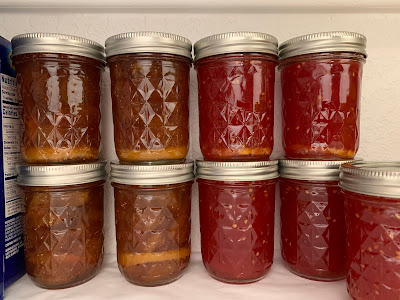Tomato Preserves/Jam
There’s something brilliant about a recipe that doesn’t ask too much of you; a recipe, in fact, where getting it exactly right would be exactly wrong; a recipe you can fiddle with, and tend to when you remember.
― Midnight Chicken: & Other Recipes Worth Living For
 |
| Pantry shelf - figs and tomatoes |
I know I write this same post every year. But you really should try tomato preserves at least once in your life.
Don't like tomatoes? Well, this is more like jam.
Don't like jam? You can add a few ingredients and make a pretty darned good barbecue sauce.
Don't eat BBQ? The preserves are good on roast beast.
Don't eat meat? Well, when the world opens up again, join me for tea and toast and just have a bite.
RECIPE:
This is a simple jam-like product (I will use "jam" and "preserves" interchangeably here). You can refrigerate it or freeze it. You can make a smaller amount or a larger one, but if you go larger you may find yourself stirring and cooking FOREVER (it takes a while for the tomato juices to "cook down"). I'll be running through this recipe and canning using a "boiling water bath."
Peel and slice tomatoes - use Roma for the most meat and least amount of juice. You peel them by boiling them in water until the skin splits. Refrigerate until you can touch without burning your fingers (or until after your nap). The skin will peel off easily. Measure what you have left. I try to use between 4 and 6 cups. I like even numbers.
 |
| Roma tomatoes from the farmers market |
Figure you will get one cup more of jam than the number of cups of tomatoes you have.
Use the same amount of sugar as tomatoes (this sounds sweet - and it is - but the lemon will cut some of that sweet. What lemon? I'm coming to that).
 |
| I think Mom always added lemon and just didn't tell Dad (he said he didn't like it). |
Thinly slice and seed a lemon. I like one or two slices per jar. Squeeze about 1/2 to 1 lemon (so you will need 2 lemons people!) into the tomatoes and sugar in your pan. I like to use a 4 quart pan as it gives me more bottom surface and the jam cooks more quickly.
Wait to add the lemon slices until about midway through the cooking.
Now, cook on medium heat until ready...I like to judge by when the liquid cooks down and drips slowly off the spoon. I've also been known to get a cracker, cool a small spoonful of jam (blow on it!) and sample it. You do not want to cook too long or you will scorch the jam or end up with tomato candy.
While cooking you can start preparing your jars. I use 1/2 pint jars and sterilize them in the dishwasher just before I start cooking. Then I get a LARGE soup pot, fill it 3/4 full of water, and start it boiling. I use a ladle, a canning funnel (I can a bit and so I need one), and tongs so I drop them and the lids in the boiling water.
 |
| I always try and keep an extra jar at hand. Any "extra" jam can go in the frig. |
Fill the jars with HOT preserves leaving about 1/4 to 1/2 "headroom" (that's the room between the top of the preserves and the top of the jar). Wipe the rim with a paper towel you have dipped in the hot water (Careful! Don't burn your fingers!). If the rim isn't clean you will not get a good seal.
Place the lid on and tighten the band just hand tight (don't get the vise-grips out!). Gently put your jars in the boiling water of the big pot. It is good if you have an insert to keep the jars just off the bottom of the pot.
 |
| The pot and insert for the boiling water bath in front. My jam funnel and tongs behind. |
Bring the water back to a boil and give it 15 minutes on a full boil. Remove the jars carefully with the tongs and place on a towel or paper covered counter. [RECYCLE! I use magazines or newspapers.]
As the jars cool you will hear the "POP" of the lids sealing. You can test the lids when cool. There should be no flex in the lid. If the lid did not seal, put that jar in the frig. and eat those first!
NOTE:
I recently read that a teaspoon or so of vinegar in the boiling water bath will keep you from ending up with mineral deposits on the outside of your jars. That can easily happen here where our water is so hard. It can also happen if you are making a large batch so you are running many jars through the "boiling water bath."




Comments
Post a Comment